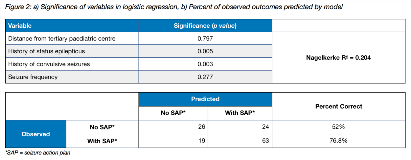Prevalence and Determinants of Seizure Action Plans in a Pediatric Epilepsy Population
Abstract number :
2.384
Submission category :
13. Health Services (Delivery of Care, Access to Care, Health Care Models)
Year :
2018
Submission ID :
499249
Source :
www.aesnet.org
Presentation date :
12/2/2018 4:04:48 PM
Published date :
Nov 5, 2018, 18:00 PM
Authors :
Michelle Chiu, University of British Columbia and BC Children's Hospital; Sharon Peinhof, BC Children's Hospital; Mahtab Borhani, BC Children's Hospital; Conrado DeGuzman, BC Children's Hospital; Cindy Siu, BC Children's Hospital; Boris Kuzeljevic, BC Chi
Rationale: Timely treatment of status epilepticus (SE) is crucial because it increases the likelihood of aborting SE and improves patient outcomes. However, the administration of rescue medications is often delayed and under-dosed (Chin et al., 2008; Fernandez et al., 2015). As SE most commonly starts in the community, appropriate management by parents, caregivers and paramedics is crucial. To this end, regional and national guidelines recommend the use of seizure action plans, which outline the steps that should be taken in case of SE (Wait et al., 2012). The purpose of this project is, ultimately, to improve management of SE by ensuring that every child with epilepsy at risk of SE in our province has an individualized seizure action plan. Methods: A survey was distributed to parents and caregivers of patients with epilepsy, aged 1 month to 19 years, at BC Children’s Hospital. The survey determined the percentage of epilepsy patients who currently have seizure action plans and identified whether respondents were interested in a Seizure Action Plan mobile application. Following chart review, univariate analysis using chi-square test and multivariate logistic regression were performed to identify variables that predict whether a patient has a seizure action plan. The variables used in the logistic regression model were distance of patient from a tertiary pediatric centre, history of SE, presence of convulsive seizures, and current seizure frequency. Results: One hundred thirty-three participants met the study’s inclusion criteria with a mean age of 10.7 years, 54% males. Sixty-one percent (n=82) currently have a seizure action plan and 53% (n=64) of parents with school-aged patients report that their child’s school has a copy. On univariate analysis, the variables that increased a patient’s likelihood of having a seizure action plan were previous history of SE (p=0.002) and convulsive seizures (p=0.001). On logistic regression, Nagelkerke R2 was 0.204. Our model correctly predicted 76.8% of patients with a seizure action plan and 52% of patients without one. The variables that were significant in the model were also history of SE (p=0.005) and presence of convulsive seizures (p =0.003). Eighty-two percent (n=111) of participants were interested in a mobile application that displays their child’s seizure action plan and only 15% (n=20) of patients currently use an epilepsy management app. Conclusions: This is one of the first studies to examine the prevalence of seizure action plans in a pediatric epilepsy population. There is a need to increase the percentage of patients with seizure action plans and to identify patients at high risk of SE. In our study, most parents and caregivers would find a Seizure Action Plan mobile application valuable in the management of their child’s epilepsy. These findings will guide the next phase of our project in which we design, implement, and evaluate such an app. Funding: None

.tmb-.png?Culture=en&sfvrsn=a567effc_0)